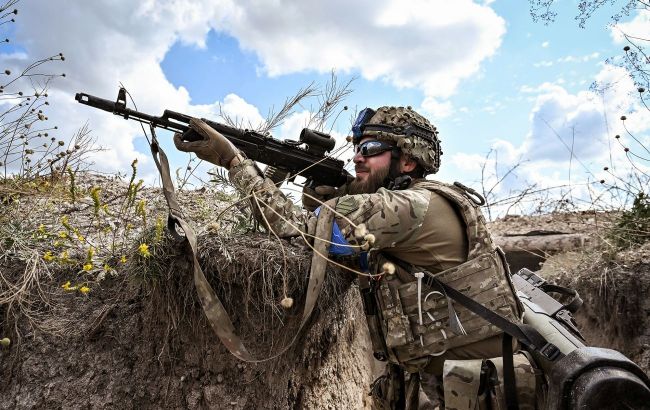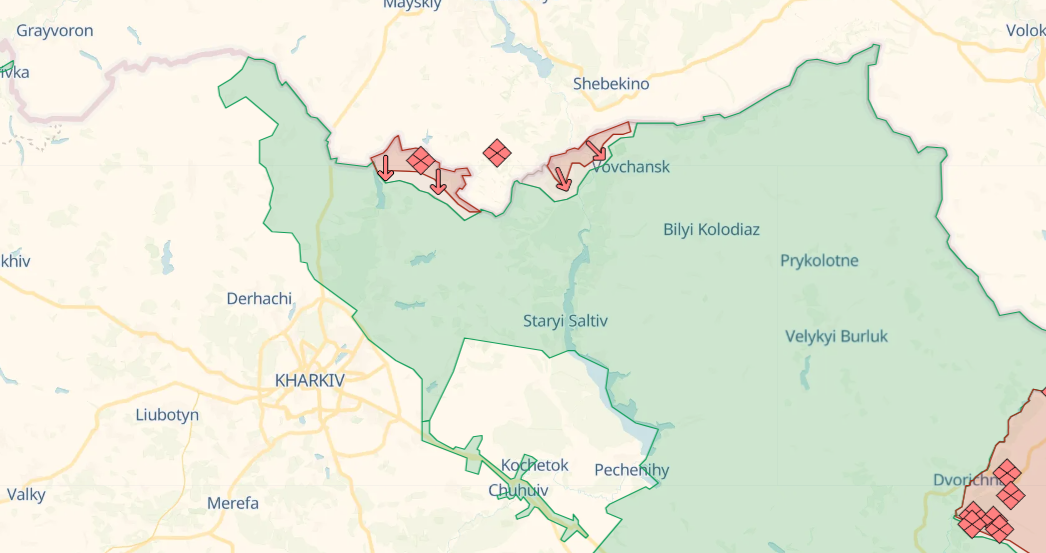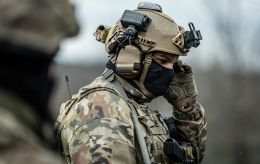Demonstration or offensive - What Russia plans starting fights in Kharkiv region
 Ukrainian troops repel a Russian offensive in the Kharkiv region (photo: Getty Images)
Ukrainian troops repel a Russian offensive in the Kharkiv region (photo: Getty Images)
Russian troops are expanding their offensive in the north of the Kharkiv region. The offensive forces have taken control of at least one settlement, and fighting is underway near Vovchansk and other areas.
RBC-Ukraine reveals what's happening, Russia's plan, and what new threats Kharkiv may face.
Sources: reports of the Institute for the Study of War (ISW), analytics and maps of the DeepState project, statements of the Commander-in-Chief of the Armed Forces of Ukraine Oleksandr Syrskyi and military speakers, and comments by expert Oleksandr Musiienko.
Contents
- Gray and red zones: what has changed in three days
- No longer an imitation. Russia's main goal and intentions
- Attack on Vovchansk and whether the Ukrainian Armed Forces can hold the city
- How close the Russians come to Kharkiv and whether there are new threats
Gray and red zones: what has changed in three days
On Friday, the Russians launched an offensive in the direction of Vovchansk and Kharkiv. The main areas of attack are along the line of the settlements of Ohirtseve-Pletenivka and Borysivka-Krasne-Strylecha. Additional forces are concentrated near the Kharkiv and Sumy regions.
The drone video shows enemy infantry south of the village of Morokhovets, destroyed equipment in the southern part of Ohirtseve, and a massive gathering near Starytsia. The enemy's actions are not sabotage but linear.
To the north of Kharkiv, the villages of Strilecha, Krasne, Pylna, and Borysivka may have been captured. On the DeepState project maps, they have moved into the “red zone” with an area of more than 50 square kilometers. The occupants are trying to storm Hlyboke and Lukiantsi towards Lyptsi, which is about 17 kilometers from the Kharkiv ring road.
In the direction of Vovchansk, the Russians could have taken Pletenivka and are most likely trying to gain a foothold on the line between Ohirtseve-Gatyshche- Starytsia-Buhrovatka. Here, maps show a “red zone” of 35 square kilometers. Judging by them, the occupiers are getting closer to the northern outskirts of Vovchansk.

Map of “red” and “gray” zones in the north of Kharkiv region (photo: deepstatemap.live)
The withdrawal from several positions has been officially confirmed. As a result, one settlement came under Russian control yesterday. The National Guard reported this without specifying its name. Ukrainian Armed Forces Commander-in-Chief Oleksandr Syrskyi assured that the enemy's plans are known and that they are responding flexibly to its actions.
“Fighting is currently ongoing in the border areas along the state border with Russia. The situation is complicated, but the Ukrainian Defense Forces are doing everything to hold defensive lines and positions, inflicting damage on the enemy,” he wrote on Telegram.
The Russian offensive in the Kharkiv region is worrying. The infantry is being continuously deployed and is moving forward with the support of artillery, aircraft, and vehicles. And judging by the number of forces involved, the advance is quite significant, says Oleksandr Musiienko, head of the Center for Military and Political Studies.
According to him, about 20,000 soldiers have already been involved in the fighting. The rest are in the Belgorod and Kursk regions. The total number may be up to 40,000. However, the enemy's capabilities should be assessed based on the speed and effectiveness of actions rather than the number.
The task No. 1 for the Armed Forces of Ukraine is not so much to push the occupiers back to Russia as to stop their advance.
“Because the enemy will try to gain a foothold on the lines, capture Vovchansk, and move another 2-3 km south. Judging by the nature of what is happening, they are preparing possible offensives on Kozacha Lopan, as well as from Hraivoron to Velyka Pysarivka (a village in Sumy region - ed.),” he said in an interview with RBC-Ukraine.
Otherwise, if the Russians see that they are able to achieve tactical success, there is little doubt that they will deploy even more troops in an attempt to develop it, the expert added.
No longer an imitation. Russia's main goal and intentions
In the initial phase of the Russian advance, it was believed to be more of an imitation than a full-fledged military operation.
“It looks exactly like the enemy is imitating a large-scale offensive with limited forces and means, like reconnaissance by combat,” said Andrii Kovalenko, head of the National Security and Defense Council's Center for Countering Disinformation, on Friday.
The attack was accompanied by information injections from “Z-war correspondents”. According to Serhiy Zhukov, an analyst at the Center for Countering Information, the enemy's IPSO (information and psychological operation) has been preparing since March. On May 10, fakes about the allegedly rapid advance on Kharkiv flooded the Internet.
The enemy is using such fakes to sow panic and demoralize the military and civilians in the Kharkiv region. This is a standard practice of warfare, as distractions and battlefield reconnaissance are used to mislead the Defense Forces, he added.
However, after three days, it is clear that this is an offensive operation by Russian troops, Musiienko said.
“The strategic goal is to semi-encircle Kharkiv. Not fighting for the city and its capture but semi-encirclement from the northern, eastern, and western directions. This is evident from the logic of the forces involved. On the other hand, there are doubts that they are capable of realizing the strategic task,” he said.
In his opinion, whether or not the occupiers will succeed in implementing it will depend on the speed and volume of Western aid packages and the readiness of our command to act and redeploy forces from Donbas to the northeast.
It is not certain that the enemy's activation in the Kharkiv region is aimed at a deep advance. Analysts at the Institute for the Study of War (ISW), in turn, believe that the strategic intention is to shackle the Ukrainian Defense Forces.
The expectation is that the “new front” will force Ukraine to bring in reserves, and in the meantime, the Russians will be able to consolidate their tactical successes west of Avdiivka and near Chasovyi Yar. In other words, it is an attempt to distract and weaken the Ukrainian defense in order to achieve a breakthrough in more vulnerable areas.
According to Ivan Tymochko, head of the Land Forces Reservists Council, the emergence of additional “hot spots” is triggered by protocols that require troops to have mandatory reserves. And this, in addition to strengthening logistics, requires an increase in personnel.
“I see the intention to put our command in a dilemma of what to defend first. That is, whether to continue defensive operations in Donetsk region with the deployment of additional forces or to move them to Kharkiv region. But the main reason for the offensive is to semi-encircle Kharkiv. In this sense, the diversion of troops is one of the elements of a large-scale operation that we are witnessing,” Musiienko emphasized.
Attack on Vovchansk and whether the Ukrainian Armed Forces can hold the city
Videos of strikes on the Siverskyi Donets dam in Staryi Saltiv and the bridge over the Vovcha river, southwest and west of Vovchansk, respectively, have been posted online. This is likely to isolate Ukrainian forces and prevent them from supporting the city's defense.
The destruction of landlines of communication indicates that Russian forces will focus on capturing Vovchansk instead of going around it and expanding the front, ISW said. The pressure on the operational rear is likely aimed at weakening units in the Kupiansk area.
It is emphasized that the Vovchansk bridgehead is unlikely to be created for an offensive on Kharkiv. Most likely, there are plans to reach Velykyi Burluk, Dvorichna and Kupiansk, although further advancement will require long operations in the open. This is something the occupiers have not demonstrated over the past year and a half.
Some Russian presence has already been spotted in Vovchansk, but the enemy was driven out, said Musiienko.
“Nevertheless, the Russians are close, and our people are doing everything to stop them. To what extent will we succeed? There are definitely chances to prevent them from entering the city. But if we fail, the enemy will try to develop an offensive in the direction of the village of Bilyi Kolodyaz,” he said.
Today, the chief patrol officer of the local police department, Oleksii Kharkivskyi, said that the situation has deteriorated significantly due to constant shelling, the town is almost destroyed and most residents have evacuated. According to Oleh Syniehubov, the head of the regional military administration, up to 500 people still remain there.
Vovchansk was occupied on the first day of the full-scale invasion on February 24, 2022. It was liberated during the Kharkiv operation in September of the same year. Due to its proximity to the Russian border, the city is under constant shelling.
How close the Russians come to Kharkiv and whether there are new threats
An attack on Kharkiv from Lyptsi is assessed as unlikely. First, it would also require lengthy operations in the open. Secondly, some units of the “North” group may not be combat-ready enough due to a lack of personnel.
To encircle the regional center, the Russians will need about 300,000 soldiers, while in the border areas, there are many times fewer. Under such scenarios, the offensive will require the transfer of troops from other areas, which will jeopardize the plans to capture the Donetsk region, according to ISW.
Expert Musiienko draws attention to the activation of the enemy's IPSOs. According to him, the Russians will try to increase the frequency of attacks on Kharkiv. And, of course, they would be satisfied with the picture of panic and people fleeing the city. It should be noted that local authorities have assured us that there are no grounds for evacuation.
However, there is a risk of advancing to Lyptsi, which is a zone from which the enemy can fire artillery, as at the beginning of a full-scale war. In fact, everything in the area of Lyptsi and to the south is a critical distance.
“We need to understand that there will be 25-30 kilometers, which is enough to provide firepower. That is, cannon artillery will be able to reach the northern and northeastern outskirts of Kharkiv. I hope that the offensive pace will be slowed down, and we will stop them as a result of comprehensive defensive actions,” Musiienko said.
It is difficult to say whether the occupiers will be able to reach the artillery line. It all depends on how quickly the reinforcements arrive at the Defense Forces, how many weapons are used, and how quickly we receive help from our partners.
“If the full range of measures is taken, I think they will not be allowed to advance more than 1-2 kilometers. If not, they will have to retreat to the defense lines in Kharkiv. They are quite strong and will be able to hold back the enemy for a long time,” the expert concluded.

